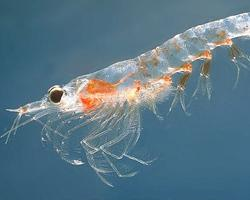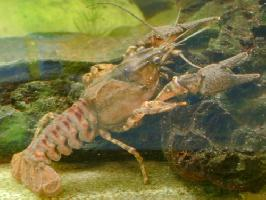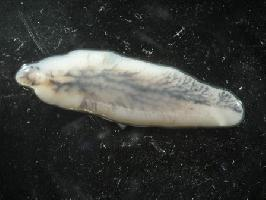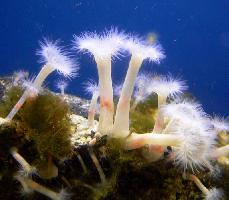
Váhy a míry
| Délka | 3 cm |
|---|
Stav ohrožení
| Neohrožen |
Popis zvířete
Northern krill (Meganyctiphanes norvegica) is a small, yet crucial, marine crustacean that plays a pivotal role in the aquatic food web of the Northern Hemisphere, particularly in the North Atlantic Ocean. This species of krill is distinguished by its slender, translucent body, which typically measures between 20 to 25 millimeters in length, although some individuals can grow up to 40 millimeters. Its body is encased in a hard exoskeleton, which provides protection and supports its external appendages.The coloration of Northern krill is predominantly a translucent reddish-brown, which camouflages it in the deep sea waters where it resides. The body of Meganyctiphanes norvegica is divided into two main parts: the cephalothorax, which is a fusion of the head and thorax, and the abdomen. The cephalothorax houses most of the sensory organs, including large compound eyes that are highly adapted to the low-light conditions of its deep-sea habitat. These eyes are crucial for detecting predators and prey in the dimly lit waters.
One of the most distinctive features of Northern krill is its bioluminescent organs, known as photophores, which are scattered across its body. These light-emitting organs can produce flashes of light, which are believed to be used for communication among individuals and possibly for evading predators by confusing them or mimicking the light patterns of other, more dangerous organisms.
Northern krill is equipped with several pairs of appendages that serve various functions. It has powerful antennae that are not only sensory organs but also help in swimming. Its mouthparts are adapted for filter feeding, allowing it to consume a wide range of microscopic food, including phytoplankton and zooplankton. This diet makes it a key link in the oceanic food chain, converting the energy from primary producers into a form that is accessible to larger predators.
The life cycle of Meganyctiphanes norvegica is complex and involves several stages, from eggs to larvae and then to adulthood. Reproduction occurs in large swarms, with females capable of producing thousands of eggs, which are released into the water column. The larvae go through several developmental stages before reaching maturity, a process that can take several months to over a year, depending on environmental conditions.
Northern krill forms vast swarms that can extend for kilometers and contain millions of individuals. These swarms are not only a spectacular natural phenomenon but also a vital food source for a wide array of marine animals, including fish, seabirds, and marine mammals like whales. The abundance and distribution of Northern krill are therefore crucial for the health and stability of marine ecosystems in the North Atlantic.
Despite its small size, the Northern krill's ecological importance cannot be overstated. It is a key species in marine food webs, a significant contributor to the ocean's carbon cycle through its feeding and excretion, and its swarms influence the behavior and distribution of many marine predators. As such, understanding the biology, behavior, and ecology of Meganyctiphanes norvegica is essential for the conservation and management of the North Atlantic marine environment.
Podobná zvířata
Nové fotografie zvířat
Top 10 zvířat
- Common cockchafer (Melolontha melolontha)
- Common house mosquito (Culex pipiens)
- Colossal squid (Mesonychoteuthis hamiltoni)
- Giant house spider (Eratigena atrica)
- Harpy eagle (Harpia harpyja)
- Fruit fly (Drosophila melanogaster)
- Australian box jelly (Chironex fleckeri)
- Common reed warbler (Acrocephalus scirpaceus)
- Proboscis monkey (Nasalis larvatus)
- Moustached guenon (Cercopithecus cephus)


